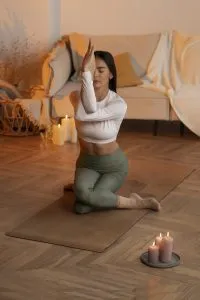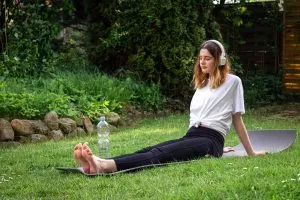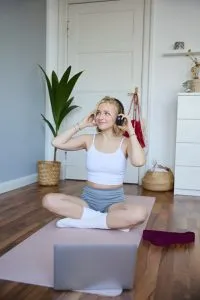Have you ever rolled out your yoga mat, taken a deep breath, and still felt… off? Like something in the room was blocking your flow, even though you were doing all the right poses.
You’re not alone.
Many yogis—new and seasoned—overlook one powerful element that can make or break your practice: your space. More specifically, how your space flows. That’s where the ancient art of Feng Shui comes in.
In this post, we’ll explore how to align your feng shui yoga mat setup with the energy of your environment, so your practice feels more grounded, intentional, and healing. Whether you’re a yoga instructor, a wellness enthusiast, or someone looking to heal through movement, this guide is for you.
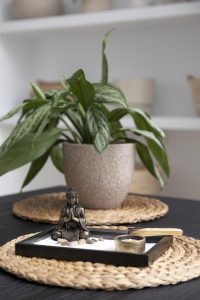
Why Feng Shui Belongs in Your Yoga Practice
Feng Shui (pronounced “fung shway”) is an ancient Chinese philosophy that focuses on harmonizing individuals with their environment. It’s all about energy flow—or chi—and how the arrangement of your space can either support or block it.
Yoga, on the other hand, is about aligning the energy within. So, when you combine the two? Magic happens.
Think of it like tuning a guitar. Yoga tunes your body and mind. Feng Shui tunes the room. Together, they create a symphony of stillness and strength.
Your Yoga Mat Is More Than Just a Mat
Let’s talk about the feng shui yoga mat itself. It’s not just a rectangle of rubber or cork—it’s your energetic anchor. Where you place it, what color it is, and what surrounds it can all influence your practice.

Yoga Mat Placement – The Commanding Position
In Feng Shui, the “commanding position” is where you can see the door without being directly in line with it. This gives you a sense of safety and control—two things your nervous system loves.
Try this: Place your yoga mat so you can see the entrance to the room, but not directly in front of it. You’ll feel more grounded and less distracted.
Declutter to Unblock Your Chi
Ever tried meditating in a messy room? It’s like trying to find peace in a traffic jam.
Clutter is one of the biggest energy blockers in Feng Shui. It creates stagnant chi, which can make you feel stuck, anxious, or even physically tense.
Before you unroll your mat, take five minutes to:
- Clear the floor
- Tidy up surfaces
- Open a window for fresh air
Pro tip: Keep a small basket nearby for yoga props and essentials. It keeps things tidy and accessible.
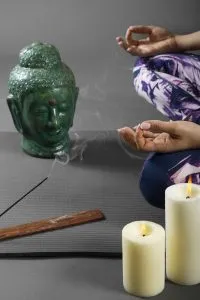
Color and Wellness – Choose Your Mat Mindfully
Colors carry energy. In Feng Shui, each color corresponds to one of the five elements—wood, fire, earth, metal, and water—and each has a different emotional and energetic impact.
Here’s a quick guide to choosing a feng shui yoga mat color:
| Color | Element | Energy | Best For |
|---|---|---|---|
| Green | Wood | Growth, healing | New beginnings, emotional balance |
| Red | Fire | Passion, vitality | Boosting motivation |
| Yellow | Earth | Stability, nourishment | Grounding and digestion |
| White | Metal | Clarity, focus | Mental clarity, breathwork |
| Blue | Water | Calm, intuition | Meditation, stress relief |
Personal story: I once switched from a black mat to a soft green one during a stressful time. The difference was subtle but powerful—I felt more open, more at ease. Like my mat was giving me a hug.
Bring Nature In – Plants, Light & Energy Flow in Yoga
Nature is a key player in both yoga and Feng Shui. It reminds us to breathe, grow, and stay rooted.
Add Greenery
Plants purify the air and uplift the energy. Choose low-maintenance ones like:
- Snake plant
- Peace lily
- Pothos
Place them near your mat, but not in your direct practice space—they should support, not distract.

Let There Be Light
Natural light is ideal. If that’s not possible, use warm, soft lighting. Avoid harsh overhead lights that can feel sterile or draining.
Use the Five Elements to Balance Your Space
Feng Shui is built on the five elements. Here’s how to incorporate them into your yoga space:
- Wood: Plants, wooden blocks, green tones
- Fire: Candles, red accents, sunlight
- Earth: Crystals, clay pots, earthy colors
- Metal: Singing bowls, white or metallic decor
- Water: Flowing fabrics, blue tones, water features
You don’t need all five—just enough to feel balanced. Trust your intuition.
Let Go of Perfection – Embrace the Human Moments
One of the most beautiful takeaways from combining Feng Shui and yoga is learning to embrace imperfection.
Remember the story of the yoga teacher who showed up with dirty feet? Or the client who was embarrassed about a stained bathtub? These “flaws” are actually portals to connection. They remind us we’re human. And that’s where the real healing begins.
So, if your mat isn’t perfectly aligned or your space isn’t Pinterest-worthy, it’s okay. What matters is the intention you bring to it.

FAQs: Feng Shui Yoga Mat & Practice
1. Where should I place my yoga mat for best energy flow?
Place your mat in the commanding position—facing the door but not directly in line with it. Avoid placing it under beams, near clutter, or in high-traffic areas.
2. What’s the best color for a yoga mat in Feng Shui?
It depends on your intention. Green for healing, red for energy, blue for calm. Choose a color that supports your current emotional or physical needs.
3. Can I practice yoga in a small or shared space?
Absolutely. Even a corner can become sacred with intention. Use a screen, curtain, or rug to define your space. Keep it clean and clutter-free.
4. How do I cleanse the energy of my yoga space?
Use sage, palo santo, or sound (like a singing bowl). Open windows to let fresh air in. Set an intention before each practice.
5. Do I need to follow all Feng Shui rules?
Nope. Feng Shui is a guide, not a rulebook. Start with what resonates and build from there. Your intuition is your best compass.
Final Thoughts: Your Mat, Your Sanctuary
Your yoga mat is more than a workout zone—it’s a portal to presence. And when you align it with the principles of Feng Shui, you create a space that supports your body, mind, and spirit.
So next time you roll out your mat, ask yourself:
- Is this space supporting my energy?
- What can I shift to feel more grounded?
- How can I make this moment more intentional?
You don’t need a fancy studio. Just a mat, a little awareness, and a willingness to show up.

Ready to Transform Your Practice?
If this post inspired you, share it with a fellow yogi or try rearranging your space today.
Namaste 🙏

